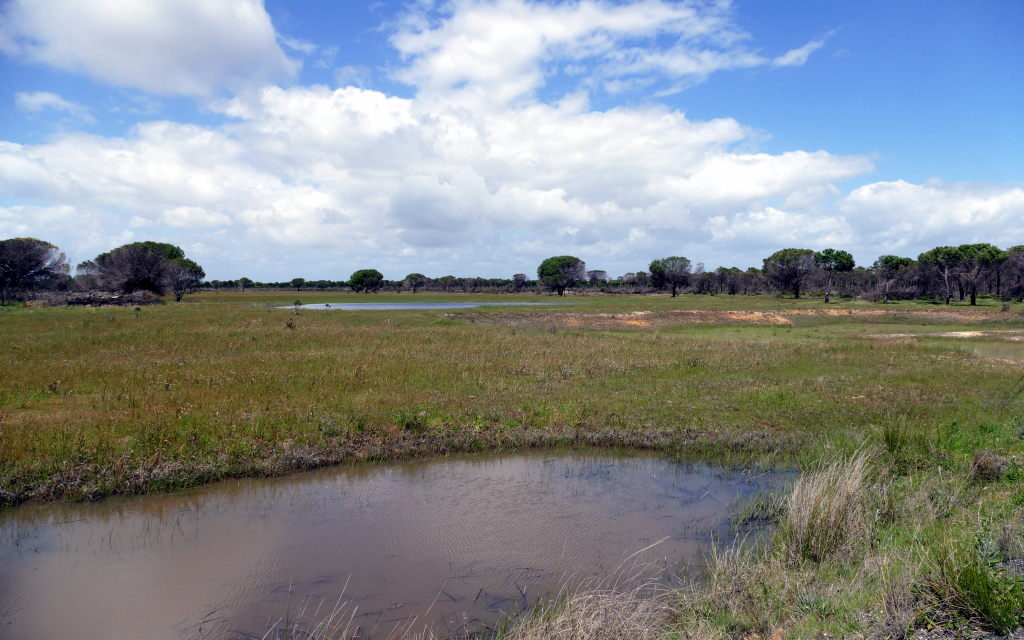Wetlands in Andalusia
Ecosystems with maximum plant productivity – remarkable habitat for migratory birds and amphibians.
It is no surprise that the most important Andalusian wetlands are located on the coast. There the mouths of the rivers match the seasonal contributions of the river waters with the periodic tidal regime, precisely in plains favourable to water expansion and sediment deposition. These conditions are ideal for creating marshes, areas of great complexity and profuse biodiversity.
For the naturalist, the great attraction of wetlands in Andalusia lies in their morphological diversity, dependent on four highly variable factors such as their surface, depth, seasonality and their concentration in mineral salts, the combination of which creates an infinity of ecological situations. The main biotopes are found in the Inventario de Humedales de Andalucía.
Coastal wetlands, estuaries and marshes: the Atlantic basin is characterized by rivers of greater flow and tides of greater amplitude than the Mediterranean basin, thus housing the most important wetlands of Andalusia: Castro Marim (in Portugal) – Isla Cristina (Guadiana River), Marshlands Odiel (Odiel River), Doñana (Guadalquivir River), Cadiz Bay (Guadalete River), Marismas del Barbate (Barbate River) and its prelude La Janda Lagoon. As for the Mediterranean basin, it has some important coastal wetlands: Estuaries of the Guadiaro and Guadalhorce, Charca de Suarez (Guadalfeo River), Salinas de Punta Entinas El Sabinar, Andarax, Salinas de Cabo de Gata and Almanzora.
Far from the coast, the interior endorheic complexes are abundant in the depression of the Guadalquivir. These are drainage basins that form lagoons and do not discharge into the hydrographic network. The semi-arid climate of Andalusia implies that these lagoons usually dry out before the next rainy season. As for vegetation, they are usually surrounded by a narrow strip of tamarisk. Laguna de Fuente de Piedra is the largest inland wetland in Andalusia. Zoñar Lagoon, with its permanent waters, is the only lake in Andalusia. An exceptional case for the region is the Padul Lagoon that sits on an old bog.
I have sampled hundreds of temporary pools that are literally full of life … I have often wondered how is it possible that so many predatory insects can grow there?

A temporary Mediterranean pond, one of the commonest type of wetlands in Andalusia.
The most spectacular of continental crustaceans: Triops mauritanicus.
Mediterranean temporary ponds are small wetlands, a few hundred square meters, or much less, that dry out quickly. Depending on the presence in the soil of salts that dissolve in very variable concentrations, lagoons and ponds may have fresh, brackish or brine water (hypersaline). This condition is favorable to the existence of a greater diversity of aquatic vertebrates and invertebrates.
Wetlands are characterized by a primary production far superior to that of other continental ecosystems. Very specialized vegetation develop: aquatic, amphibious fresh and salt water (coastal and continental halophilic vegetation).
Indeed, wetlands are very important for biodiversity, particularly for aquatic birds, as a feeding and resting area. The temporary ponds and lagoons do not allow the survival of fish and crayfish (Procambarus clarkii) that need permanent waters, and constitute a very favorable environment for amphibians and fairy shrimp crustaceans. Also note the presence of dragonflies linked to stagnant waters: generalist species with great capacity for colonization.
Another memory, at the Palacio del Rey de Doñana: a distant pink mass of glowing flamingos amid the lush green swamps.
The beauty of aquatic buttercup flowers (Ranunculus spec).
It is no surprise that the most important Andalusian wetlands are located on the coast. There the mouths of the rivers match the seasonal contributions of the river waters with the periodic tidal regime, precisely in plains favourable to water expansion and sediment deposition. These conditions are ideal for creating marshes, areas of great complexity and profuse biodiversity.
For the naturalist, the great attraction of wetlands in Andalusia lies in their morphological diversity, dependent on four highly variable factors such as their surface, depth, seasonality and their concentration in mineral salts, the combination of which creates an infinity of ecological situations. The main biotopes are found in the Inventario de Humedales de Andalucía.
Estuary on the coast of Huelva, between land and sea.
Coastal wetlands, estuaries and marshes: the Atlantic basin is characterized by rivers of greater flow and tides of greater amplitude than the Mediterranean basin, thus housing the most important wetlands of Andalusia: Castro Marim (in Portugal) – Isla Cristina (Guadiana River), Marshlands Odiel (Odiel River), Doñana (Guadalquivir River), Cadiz Bay (Guadalete River), Marismas del Barbate (Barbate River) and its prelude La Janda Lagoon. As for the Mediterranean basin, it has some important coastal wetlands: Estuaries of the Guadiaro and Guadalhorce, Charca de Suarez (Guadalfeo River), Salinas de Punta Entinas El Sabinar, Andarax, Salinas de Cabo de Gata and Almanzora.
The lagoon of Moguer, a typical Mediterranean pond of Doñana.
Far from the coast, the interior endorheic complexes are abundant in the depression of the Guadalquivir. These are drainage basins that form lagoons and do not discharge into the hydrographic network. The semi-arid climate of Andalusia implies that these lagoons usually dry out before the next rainy season. As for vegetation, they are usually surrounded by a narrow strip of tamarisk. Laguna de Fuente de Piedra is the largest inland wetland in Andalusia. Zoñar Lagoon, with its permanent waters, is the only lake in Andalusia. An exceptional case for the region is the Padul Lagoon that sits on an old bog.
A temporary Mediterranean pond, one of the commonest type of wetlands in Andalusia.
Mediterranean temporary ponds are small wetlands, a few hundred square meters, or much less, that dry out quickly. Depending on the presence in the soil of salts that dissolve in very variable concentrations, lagoons and ponds may have fresh, brackish or brine water (hypersaline). This condition is favorable to the existence of a greater diversity of aquatic vertebrates and invertebrates.
The most spectacular of continental crustaceans: Triops mauritanicus.
Wetlands are characterized by a primary production far superior to that of other continental ecosystems. Very specialized vegetation develop: aquatic, amphibious fresh and salt water (coastal and continental halophilic vegetation).
Indeed, wetlands are very important for biodiversity, particularly for aquatic birds, as a feeding and resting area. The temporary ponds and lagoons do not allow the survival of fish and crayfish (Procambarus clarkii) that need permanent waters, and constitute a very favorable environment for amphibians and fairy shrimp crustaceans. Also note the presence of dragonflies linked to stagnant waters: generalist species with great capacity for colonization.
I have sampled hundreds of temporary pools that are literally full of life … I have often wondered how is it possible that so many predatory insects can grow there? Another memory, at the Palacio del Rey de Doñana: a distant pink mass of glowing flamingos amid the lush green swamps.








